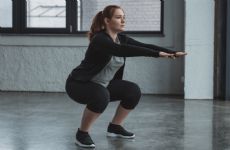|
Every month The Go Get It Guide is your destination for motivation, musings on random goals and probably pop culture references. It's a space where we'll sort through the PR pitches and news, then share our honest thoughts on what's happening in the health and fitness world, what's on the horizon and just what we think of that video the internet obsessed over last week. Check in each month to Spark, Sweat, Smile, Savor and Shop with us! Sweat: Hulk Arms and Abs of SteelFor decades women have feared the dreaded "Hulk arms" and muscular thighs, steering clear of the weight room for fear that they would build up unattractive, masculine muscle. And so they (and I) gravitated toward exercises that felt tailored specifically for women—Zumba, Pilates, yoga, water aerobics—convinced that these were the ones that would give them the slim, "toned" and defined look that they so desired. For years I only printed out workouts or watched exercise videos featuring women with titles that included words like "toning" and "lean muscle." If the woman in the video looked like a ballet dancer or ex-Victoria's Secret model, I wanted what she was selling. But I was wrong, and so are a lot of other women. A few weeks ago, I talked a friend into doing a 12-week training program focused on resistance training. After picking up running and dropping nearly 40 pounds, she was determined to continue working on her body and improving her health but had hit a bit of a plateau. While her endurance was on point, she wasn't noticing changes in her body anymore and asked, "What more can I do when I'm already doing all this running?" "Strength. Training," was my only answer; resistance was her only response. After throwing out facts and relatable anecdotes and flexing maybe a little bit, I was finally able to convince her to add some weight to her cardio-fueled routine. By the end of this post, I hope I've convinced any non-believers, too. No matter your ultimate goals, some degree of resistance training is beneficial for every person. I repeat, every person. Not only has it been shown to raise the resting metabolic rate by seven percent in just 10 weeks in previously untrained adults, but, according to the American Council on Exercise, regular resistance training can also help to ensure you do not lose muscle as you age, improve overall body composition, increase low-back health and improve the ability of older adults to function in daily activities. Plus, muscle in the body requires more energy, meaning you burn more calories at rest when you build up your muscle. With all those amazing benefits, why should the guys have all the fun? Lucky for all of us, there's been a resurgence of women proudly infiltrating the weight room and grabbing those heavy weights. My aforementioned friend echoed the sentiments of so many women about her fear of strength training, but by the end of the 12-week program, she was lifting heavier dumbbells, perfecting her form and really noticing small changes in her overall body composition. While I had to talk her into picking up her first 20-pound weight, she ended up being surprised at how strong her body really was, and that revelation right there is why I solemnly believe that every woman should challenge herself to hit the barbell rack or get to know the dumbbell station sooner rather than later. One of the most common myths in the gym is that grabbing that set of heavy dumbbells will ultimately lead to unattractive and/or bulky muscles, which is enough to keep anyone who loves their short skirts and tank tops far away from the weight rack. It's a myth that has kept women out of the weight room and up onto the treadmill. It's a myth that is perpetuated by Internet trolls like this guy who called out the muscles displayed by U.S. Olympic gold medalist gymnasts as unattractive rather than, um, I don't know, seriously impressive. But it's simply that—a myth. Check out Instagram fitness influencers like Kelsey Wells, Morit Summers, Alex Silver-Fagan or Estelle Archer and you'll quickly see that muscle doesn't have to mean manly. For most women, adding resistance training to their routine will actually make them appear more slender, due to the fact that muscle is more dense than fat. In fact, very few women possess the genetic makeup to even allow them to achieve visible muscular hypertrophy, or an increase in muscle mass. Once you can get beyond that concept that's been drilled into our heads for so many years, you'll quickly find that picking up and putting down heavy things could be the thing that actually helps you fall in love with your body, biceps and all. For those not bothered by the concept of building muscle, it's a fear of looking like a rookie or simple ignorance that keeps them from stepping foot in the weight room. Intimidation is not easy to overcome—especially if your gym weight room is inhabited by giant men blasting Metallica at full volume while they grunt their way through their 300-pound back squats—but it is worth it. For me, I simply didn't know what to do once I got in there. The few times I ventured into the weight area, I'd grab a pair of 10-pound dumbbells, rep out a few bicep curls and then walk around aimlessly, pretending I was contemplating my next move before rushing back to the more familiar cardio machine territory. It took signing up for (and becoming obsessed) Orangetheory Fitness before I finally started to understand how to use dumbbells, Bosu balls, TRX straps and more to work the various muscles of the body. Once I had that base knowledge, I was able to do my own research online and on Instagram to find new moves to add variety to my own routine. And don't think you can't do this at home, either—there are plenty of ways to add resistance training to your life without setting foot in a gym. It's all about learning how to utilize your bodyweight and small pieces of equipment (dumbbells, resistance bands, mini bands, etc.) in the right ways. If it's a fear of the unknown that is holding you back, talk to a trainer at the gym to see if they will walk you through a beginner resistance training routine to get you started. Or, consider signing up for a resistance training-focused group class to get comfortable with lifting weights in a communal environment before hitting the weight room on your own. I loved doing the 12-week program because it forced me to get out of my comfort zone and allowed me to gradually increase my repetitions slowly without feeling like I had to keep up with anyone but myself. Though, please note that if you do decide to strength train at home, form is key. Injuries can happen easily once weight is added, so be sure that you fully understand how to perform the exercise and be careful to listen to your body if it's exhibiting signs of pain. If you had asked me five years ago if I ever thought I'd be here writing about my love affair with weights, I'd have had you carted off to the insane asylum. And, yet, here I am, steadily working toward the day I can add another weight plate to my deadlift, barbell back squat or biceps curl. Strength training has given me confidence in the muscular shape of my body and a confidence in how I carry myself, both in the gym and out in the real world. Start small with weights that challenge you but don't disrupt your form before increasing weight and I promise that within a few weeks, you too will be amazed by the strength inside your mind and your body. Spark: The Season of GivingSports figures often get a bad rap, but this story about recently crowned World Series Champion Boston Red Sox Manager Alex Cora brings us back to what it's all about—making people smile and using your influence to make a difference. When signing his contract, Cora wasn't most concerned with how many zeroes he could add to his paycheck, but rather with how much good he could do with his opportunity on the big stage. According to NESN, the only thing on Cora's mind during his contract negotiation was his home—Puerto Rico. Recently devastated by Hurricanes Irma and Maria and in need of basic necessities, Cora knew the island needed help. When it came time to negotiate, he asked the Red Sox for a plane full of supplies to deliver to the people and was able to help 300 families in his hometown. Cue the happy tears. As we head into November and the season of giving, let's remember to stay focused on the meaning of the season—gratitude, generosity and good vibes. Commit yourself to finding a volunteer organization that could use your help, not just this month, but at least a few times throughout the year. Reconnect with friends with whom you've lost touch. Help out someone less fortunate without expecting anything in return. The feeling you'll get deep down in your soul is enough to carry you through any tough workout, hard day at the office or bad week. In a world full of bad news, channel Cora and do something good. Share your stories of strength training or giving back below! |
Related Entries
More From SparkPeople
|























